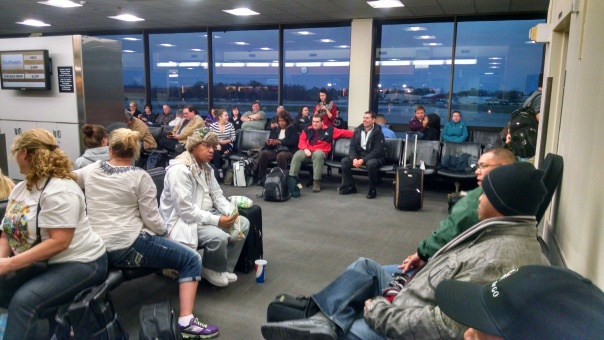A few weeks ago, I signed a contract to do a little work with an organization on the Mississippi Gulf Coast. I must admit that it was nice to get out of the Chicago winter, even if it was only for a few days. On my way home, I found myself waiting for a delayed airplane at a Southwest Airlines gate at the Louis Armstrong New Orleans International Airport. As time elapsed and the plane became increasingly more late, people understandably became more agitated and upset. It was in this moment I saw a Southwest Airlines gate agent (I think his name was Aaron) demonstrate the type of leadership that every non-profit executive director and fundraising professional could learn from.
Let me attempt to tell this story pictorially.

In the picture above, you see that no one was particularly happy. No one is smiling. There are some arms crossed. In fact, every time the gate agent used the PA system to announce a new piece of information, there were audible groans and grousing from weary travelers. It wasn’t a pretty scene.
Then something happened as you can see in the pictures below . . .

Uh-huh . . . your eyes aren’t deceiving you. You see people in the picture above line dancing.

Yep . . . this last picture is the gate agent dancing with one of those delayed travelers. What you can’t hear is a fellow passenger playing music on his accordion.
So, what happened?
Simply put, the gate agent realized that people were unhappy, and he stepped into the leadership void and filled it. However, what was most impressive was that he didn’t have many resources at his disposal. Over the course of more than an hour, the gate agent facilitated the following activities with people in the gate:
- charades contest
- trivia game
- line dancing
- talent show (e.g. an accordion player, magician, and a 7-year-old girl performing her dance competition routine)
When the delayed aircraft pulled up the gate, no one noticed because they were too busy having fun. There wasn’t a frown to be found anywhere.
Mission accomplished! 🙂
So, what happened here that your non-profit organization can learn from?
Well, scroll back up to the first picture of angry people being told that their flight was delayed. Now pretend that those aren’t angry travelers, and they are instead angry donors and key community stakeholders.
The reality is this can happen to the best of us. Our organizations make decisions that make people upset. Sometimes management decisions simply don’t work out. Other times external circumstances lead us down roads fraught with crisis.
When this happens, people get angry. More oftentimes than not, you aren’t in a position to wave a magic wand and fix the situation, but you better do something to keep things from getting worse. (Very similar to the Southwest Airlines gate agent’s situation, right?)
Here are a few tips when your organization finds itself in similar circumstances:
- Take responsibility
- Don’t make excuses (even though you want to explain what is happening and why it is occurring)
- Empathize with those who aren’t happy (we’ve all been there)
- Do whatever you can to make people happy even if you can’t fix the problem (ask those who are upset if there is anything you can do to make the situation better)
- Coordinate your response (especially when dealing with a crisis, only have one spokesperson dealing with restless people)
- Know your resources and use them!
This last bullet point sounds simple, but it is hard to do when you’re in the middle of a challenging situation. However, the reality is that most non-profit organizations have many more resources than the Southwest Airlines gate agent I’ve highlighted in this post.
The following are just a few examples of resources at most non-profit’s fingertips:
- talented staff
- board volunteers
- clients
- donors
- community supporters (e.g. program volunteers)
- collaborative partners (e.g. other non-profit partners)
- technology
- budgets (albeit probably stretched thin)
- facilities (albeit not every non-profit is endowed with physical space)
This short list of resources is like a list of food ingredients for a chef. Surely, some spontaneous recipe can be cooked up?
The reality is that whatever mess you find yourself in, you don’t have to be in it alone.
Please scroll down and use the comment box below to share your thoughts and experiences. No one is in this alone. We can all learn from each other.
Here’s to your health!
Erik Anderson
Founder & President, The Healthy Non-Profit LLC
www.thehealthynonprofit.com
erik@thehealthynonprofit.com
http://twitter.com/#!/eanderson847
http://www.facebook.com/eanderson847
http://www.linkedin.com/in/erikanderson847

Eric, great story, great pictures and use of pictures to draw your “audience” into the story.
More importantly, great example of what social enterprises should be doing and the way they should be thinking. (HECK, not just social enterprises, if more for profits would change their mindset to this way of thinking, life would be so much better!)
You rock. Thanks.
I rock? Awww shucks. Thanks, Kelley. BTW, I too wish more for-profits and non-profits approached their work like that Southwest gate agent.